Analysis of ASIC v David Hobbs [2012] NSWSC 1276: A Case Study in Law
VerifiedAdded on 2021/05/31
|11
|2428
|83
Case Study
AI Summary
This case study examines the ASIC v David Hobbs [2012] NSWSC 1276 case, focusing on David Hobbs' involvement in an unregistered investment scheme that defrauded investors of over $50 million. Hobbs was found guilty of multiple breaches, including providing false information, failing to adhere to financial regulations, and misusing his position for personal gain. The court addressed Hobbs' contraventions of directors' duties, such as failing to act in good faith and avoid conflicts of interest. The ruling resulted in a complete ban on Hobbs' involvement in any business in Australia, along with specific prohibitions on advising, selling, or buying securities. The case highlights the importance of adhering to corporate law, directors' responsibilities, and the severe penalties associated with breaches of duty, emphasizing the need for legal and financial counsel for directors. The case study also provides insights into the relevance of the court ruling, the penalties for breaching director responsibilities, and the protection of investors and fund administrators.
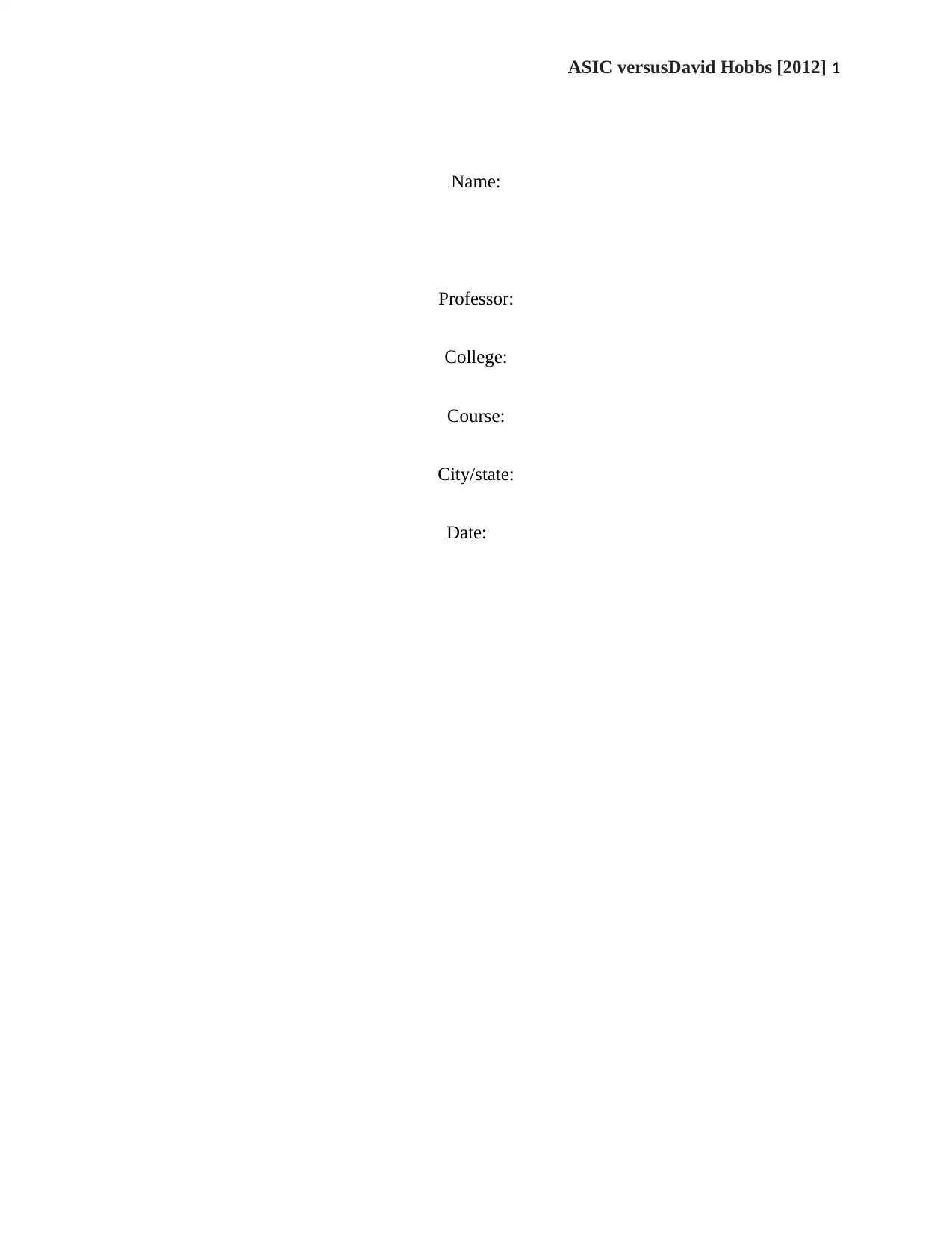
ASIC versusDavid Hobbs [2012] 1
Name:
Professor:
College:
Course:
City/state:
Date:
Name:
Professor:
College:
Course:
City/state:
Date:
Paraphrase This Document
Need a fresh take? Get an instant paraphrase of this document with our AI Paraphraser
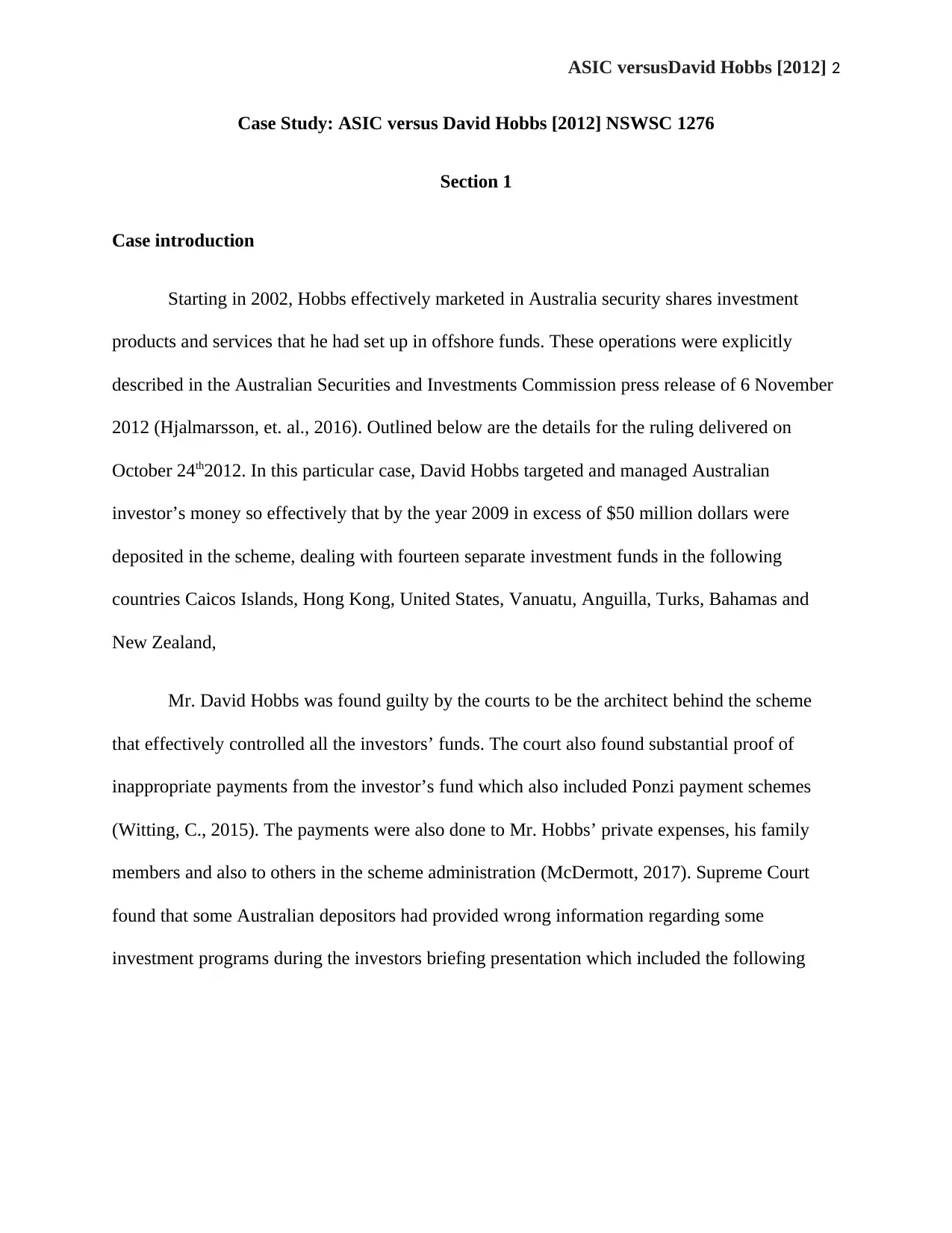
ASIC versusDavid Hobbs [2012] 2
Case Study: ASIC versus David Hobbs [2012] NSWSC 1276
Section 1
Case introduction
Starting in 2002, Hobbs effectively marketed in Australia security shares investment
products and services that he had set up in offshore funds. These operations were explicitly
described in the Australian Securities and Investments Commission press release of 6 November
2012 (Hjalmarsson, et. al., 2016). Outlined below are the details for the ruling delivered on
October 24th2012. In this particular case, David Hobbs targeted and managed Australian
investor’s money so effectively that by the year 2009 in excess of $50 million dollars were
deposited in the scheme, dealing with fourteen separate investment funds in the following
countries Caicos Islands, Hong Kong, United States, Vanuatu, Anguilla, Turks, Bahamas and
New Zealand,
Mr. David Hobbs was found guilty by the courts to be the architect behind the scheme
that effectively controlled all the investors’ funds. The court also found substantial proof of
inappropriate payments from the investor’s fund which also included Ponzi payment schemes
(Witting, C., 2015). The payments were also done to Mr. Hobbs’ private expenses, his family
members and also to others in the scheme administration (McDermott, 2017). Supreme Court
found that some Australian depositors had provided wrong information regarding some
investment programs during the investors briefing presentation which included the following
Case Study: ASIC versus David Hobbs [2012] NSWSC 1276
Section 1
Case introduction
Starting in 2002, Hobbs effectively marketed in Australia security shares investment
products and services that he had set up in offshore funds. These operations were explicitly
described in the Australian Securities and Investments Commission press release of 6 November
2012 (Hjalmarsson, et. al., 2016). Outlined below are the details for the ruling delivered on
October 24th2012. In this particular case, David Hobbs targeted and managed Australian
investor’s money so effectively that by the year 2009 in excess of $50 million dollars were
deposited in the scheme, dealing with fourteen separate investment funds in the following
countries Caicos Islands, Hong Kong, United States, Vanuatu, Anguilla, Turks, Bahamas and
New Zealand,
Mr. David Hobbs was found guilty by the courts to be the architect behind the scheme
that effectively controlled all the investors’ funds. The court also found substantial proof of
inappropriate payments from the investor’s fund which also included Ponzi payment schemes
(Witting, C., 2015). The payments were also done to Mr. Hobbs’ private expenses, his family
members and also to others in the scheme administration (McDermott, 2017). Supreme Court
found that some Australian depositors had provided wrong information regarding some
investment programs during the investors briefing presentation which included the following
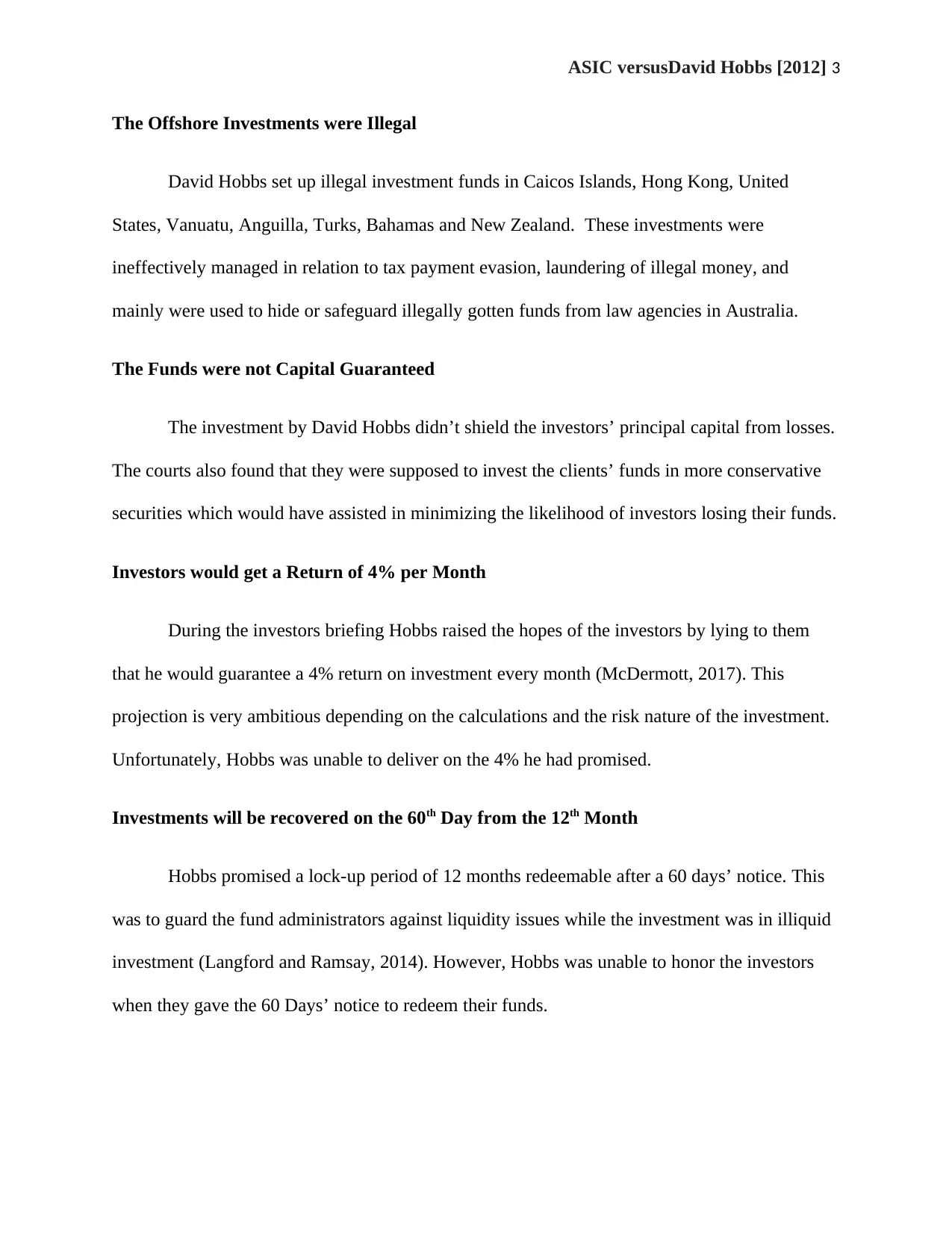
ASIC versusDavid Hobbs [2012] 3
The Offshore Investments were Illegal
David Hobbs set up illegal investment funds in Caicos Islands, Hong Kong, United
States, Vanuatu, Anguilla, Turks, Bahamas and New Zealand. These investments were
ineffectively managed in relation to tax payment evasion, laundering of illegal money, and
mainly were used to hide or safeguard illegally gotten funds from law agencies in Australia.
The Funds were not Capital Guaranteed
The investment by David Hobbs didn’t shield the investors’ principal capital from losses.
The courts also found that they were supposed to invest the clients’ funds in more conservative
securities which would have assisted in minimizing the likelihood of investors losing their funds.
Investors would get a Return of 4% per Month
During the investors briefing Hobbs raised the hopes of the investors by lying to them
that he would guarantee a 4% return on investment every month (McDermott, 2017). This
projection is very ambitious depending on the calculations and the risk nature of the investment.
Unfortunately, Hobbs was unable to deliver on the 4% he had promised.
Investments will be recovered on the 60th Day from the 12th Month
Hobbs promised a lock-up period of 12 months redeemable after a 60 days’ notice. This
was to guard the fund administrators against liquidity issues while the investment was in illiquid
investment (Langford and Ramsay, 2014). However, Hobbs was unable to honor the investors
when they gave the 60 Days’ notice to redeem their funds.
The Offshore Investments were Illegal
David Hobbs set up illegal investment funds in Caicos Islands, Hong Kong, United
States, Vanuatu, Anguilla, Turks, Bahamas and New Zealand. These investments were
ineffectively managed in relation to tax payment evasion, laundering of illegal money, and
mainly were used to hide or safeguard illegally gotten funds from law agencies in Australia.
The Funds were not Capital Guaranteed
The investment by David Hobbs didn’t shield the investors’ principal capital from losses.
The courts also found that they were supposed to invest the clients’ funds in more conservative
securities which would have assisted in minimizing the likelihood of investors losing their funds.
Investors would get a Return of 4% per Month
During the investors briefing Hobbs raised the hopes of the investors by lying to them
that he would guarantee a 4% return on investment every month (McDermott, 2017). This
projection is very ambitious depending on the calculations and the risk nature of the investment.
Unfortunately, Hobbs was unable to deliver on the 4% he had promised.
Investments will be recovered on the 60th Day from the 12th Month
Hobbs promised a lock-up period of 12 months redeemable after a 60 days’ notice. This
was to guard the fund administrators against liquidity issues while the investment was in illiquid
investment (Langford and Ramsay, 2014). However, Hobbs was unable to honor the investors
when they gave the 60 Days’ notice to redeem their funds.
⊘ This is a preview!⊘
Do you want full access?
Subscribe today to unlock all pages.

Trusted by 1+ million students worldwide
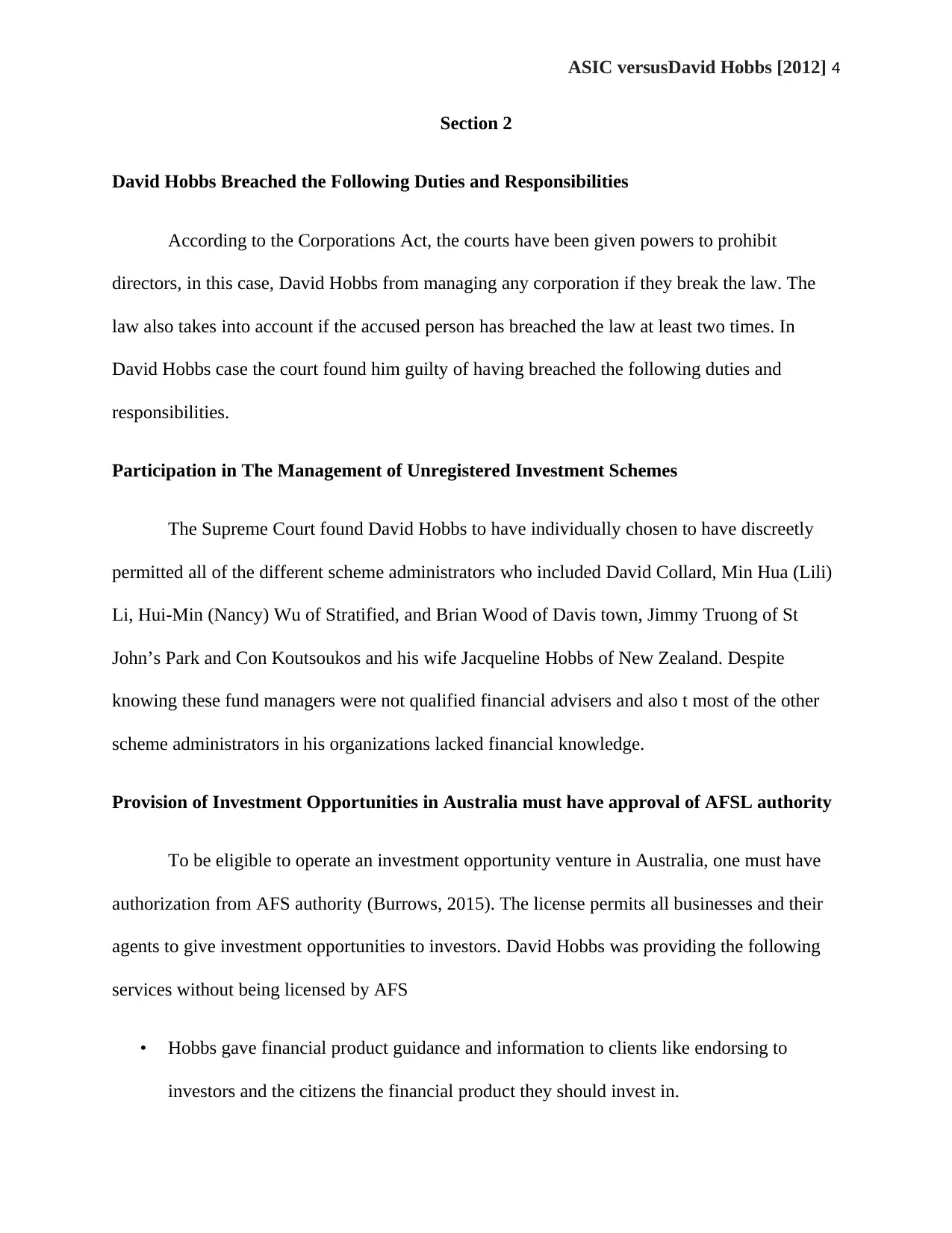
ASIC versusDavid Hobbs [2012] 4
Section 2
David Hobbs Breached the Following Duties and Responsibilities
According to the Corporations Act, the courts have been given powers to prohibit
directors, in this case, David Hobbs from managing any corporation if they break the law. The
law also takes into account if the accused person has breached the law at least two times. In
David Hobbs case the court found him guilty of having breached the following duties and
responsibilities.
Participation in The Management of Unregistered Investment Schemes
The Supreme Court found David Hobbs to have individually chosen to have discreetly
permitted all of the different scheme administrators who included David Collard, Min Hua (Lili)
Li, Hui-Min (Nancy) Wu of Stratified, and Brian Wood of Davis town, Jimmy Truong of St
John’s Park and Con Koutsoukos and his wife Jacqueline Hobbs of New Zealand. Despite
knowing these fund managers were not qualified financial advisers and also t most of the other
scheme administrators in his organizations lacked financial knowledge.
Provision of Investment Opportunities in Australia must have approval of AFSL authority
To be eligible to operate an investment opportunity venture in Australia, one must have
authorization from AFS authority (Burrows, 2015). The license permits all businesses and their
agents to give investment opportunities to investors. David Hobbs was providing the following
services without being licensed by AFS
• Hobbs gave financial product guidance and information to clients like endorsing to
investors and the citizens the financial product they should invest in.
Section 2
David Hobbs Breached the Following Duties and Responsibilities
According to the Corporations Act, the courts have been given powers to prohibit
directors, in this case, David Hobbs from managing any corporation if they break the law. The
law also takes into account if the accused person has breached the law at least two times. In
David Hobbs case the court found him guilty of having breached the following duties and
responsibilities.
Participation in The Management of Unregistered Investment Schemes
The Supreme Court found David Hobbs to have individually chosen to have discreetly
permitted all of the different scheme administrators who included David Collard, Min Hua (Lili)
Li, Hui-Min (Nancy) Wu of Stratified, and Brian Wood of Davis town, Jimmy Truong of St
John’s Park and Con Koutsoukos and his wife Jacqueline Hobbs of New Zealand. Despite
knowing these fund managers were not qualified financial advisers and also t most of the other
scheme administrators in his organizations lacked financial knowledge.
Provision of Investment Opportunities in Australia must have approval of AFSL authority
To be eligible to operate an investment opportunity venture in Australia, one must have
authorization from AFS authority (Burrows, 2015). The license permits all businesses and their
agents to give investment opportunities to investors. David Hobbs was providing the following
services without being licensed by AFS
• Hobbs gave financial product guidance and information to clients like endorsing to
investors and the citizens the financial product they should invest in.
Paraphrase This Document
Need a fresh take? Get an instant paraphrase of this document with our AI Paraphraser
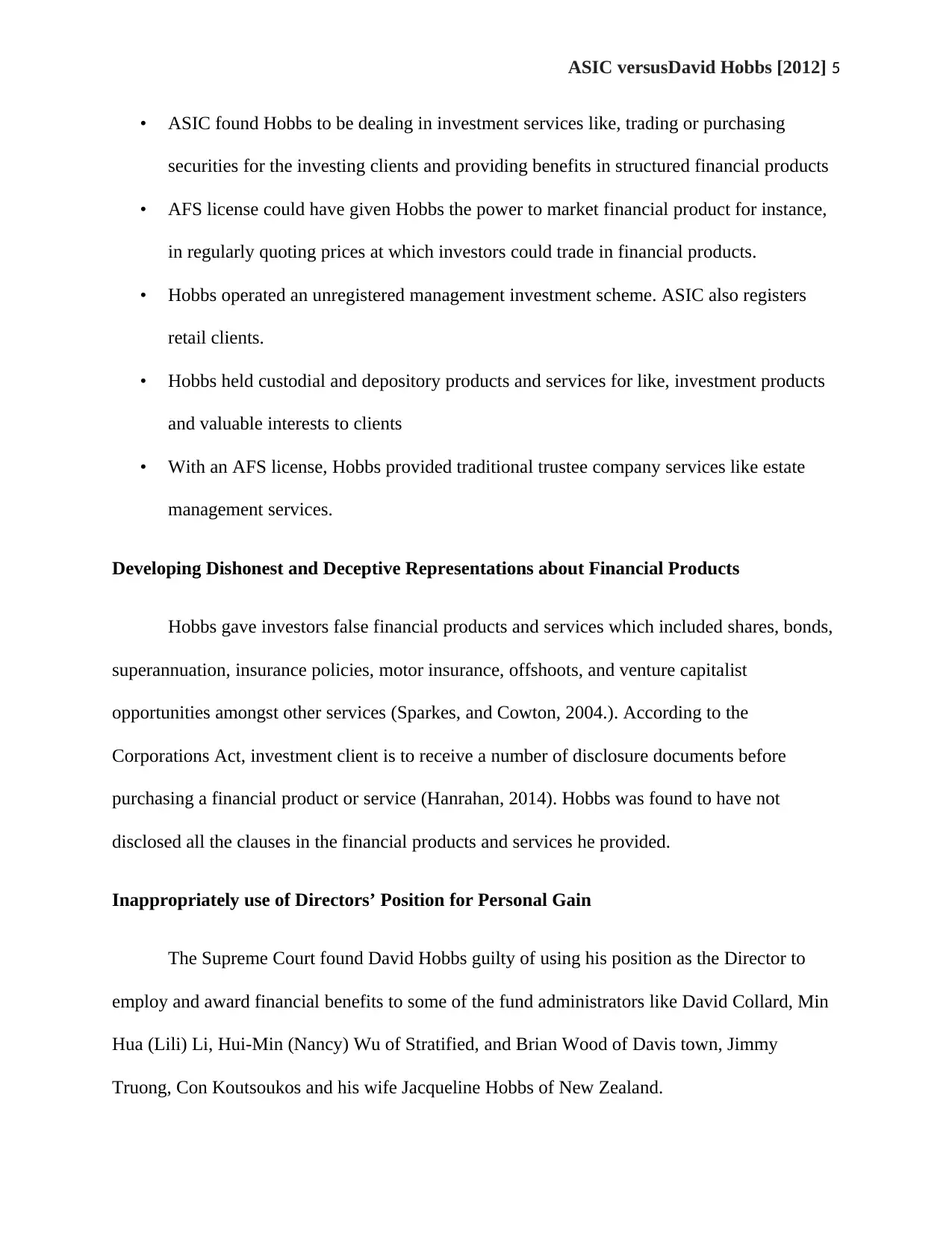
ASIC versusDavid Hobbs [2012] 5
• ASIC found Hobbs to be dealing in investment services like, trading or purchasing
securities for the investing clients and providing benefits in structured financial products
• AFS license could have given Hobbs the power to market financial product for instance,
in regularly quoting prices at which investors could trade in financial products.
• Hobbs operated an unregistered management investment scheme. ASIC also registers
retail clients.
• Hobbs held custodial and depository products and services for like, investment products
and valuable interests to clients
• With an AFS license, Hobbs provided traditional trustee company services like estate
management services.
Developing Dishonest and Deceptive Representations about Financial Products
Hobbs gave investors false financial products and services which included shares, bonds,
superannuation, insurance policies, motor insurance, offshoots, and venture capitalist
opportunities amongst other services (Sparkes, and Cowton, 2004.). According to the
Corporations Act, investment client is to receive a number of disclosure documents before
purchasing a financial product or service (Hanrahan, 2014). Hobbs was found to have not
disclosed all the clauses in the financial products and services he provided.
Inappropriately use of Directors’ Position for Personal Gain
The Supreme Court found David Hobbs guilty of using his position as the Director to
employ and award financial benefits to some of the fund administrators like David Collard, Min
Hua (Lili) Li, Hui-Min (Nancy) Wu of Stratified, and Brian Wood of Davis town, Jimmy
Truong, Con Koutsoukos and his wife Jacqueline Hobbs of New Zealand.
• ASIC found Hobbs to be dealing in investment services like, trading or purchasing
securities for the investing clients and providing benefits in structured financial products
• AFS license could have given Hobbs the power to market financial product for instance,
in regularly quoting prices at which investors could trade in financial products.
• Hobbs operated an unregistered management investment scheme. ASIC also registers
retail clients.
• Hobbs held custodial and depository products and services for like, investment products
and valuable interests to clients
• With an AFS license, Hobbs provided traditional trustee company services like estate
management services.
Developing Dishonest and Deceptive Representations about Financial Products
Hobbs gave investors false financial products and services which included shares, bonds,
superannuation, insurance policies, motor insurance, offshoots, and venture capitalist
opportunities amongst other services (Sparkes, and Cowton, 2004.). According to the
Corporations Act, investment client is to receive a number of disclosure documents before
purchasing a financial product or service (Hanrahan, 2014). Hobbs was found to have not
disclosed all the clauses in the financial products and services he provided.
Inappropriately use of Directors’ Position for Personal Gain
The Supreme Court found David Hobbs guilty of using his position as the Director to
employ and award financial benefits to some of the fund administrators like David Collard, Min
Hua (Lili) Li, Hui-Min (Nancy) Wu of Stratified, and Brian Wood of Davis town, Jimmy
Truong, Con Koutsoukos and his wife Jacqueline Hobbs of New Zealand.
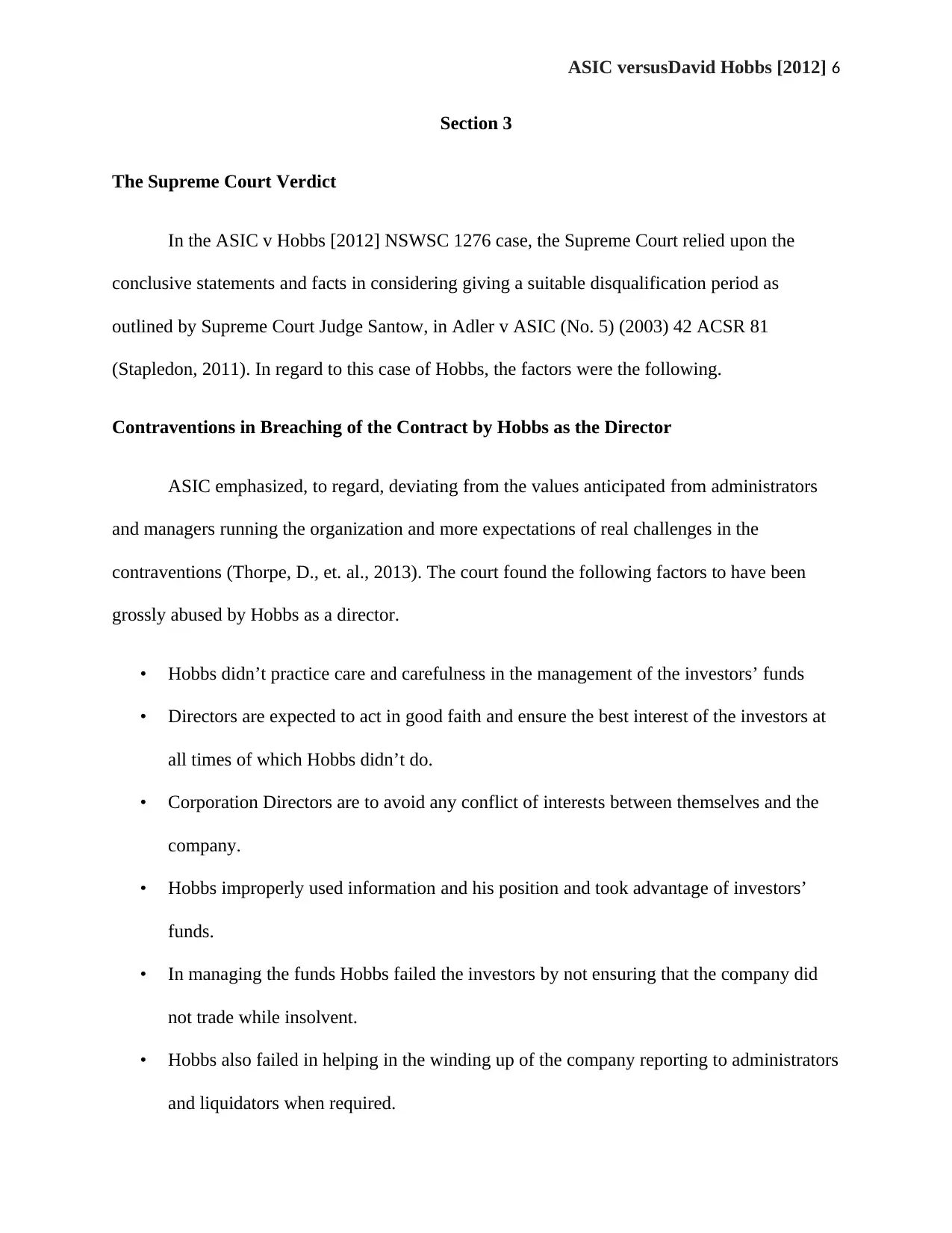
ASIC versusDavid Hobbs [2012] 6
Section 3
The Supreme Court Verdict
In the ASIC v Hobbs [2012] NSWSC 1276 case, the Supreme Court relied upon the
conclusive statements and facts in considering giving a suitable disqualification period as
outlined by Supreme Court Judge Santow, in Adler v ASIC (No. 5) (2003) 42 ACSR 81
(Stapledon, 2011). In regard to this case of Hobbs, the factors were the following.
Contraventions in Breaching of the Contract by Hobbs as the Director
ASIC emphasized, to regard, deviating from the values anticipated from administrators
and managers running the organization and more expectations of real challenges in the
contraventions (Thorpe, D., et. al., 2013). The court found the following factors to have been
grossly abused by Hobbs as a director.
• Hobbs didn’t practice care and carefulness in the management of the investors’ funds
• Directors are expected to act in good faith and ensure the best interest of the investors at
all times of which Hobbs didn’t do.
• Corporation Directors are to avoid any conflict of interests between themselves and the
company.
• Hobbs improperly used information and his position and took advantage of investors’
funds.
• In managing the funds Hobbs failed the investors by not ensuring that the company did
not trade while insolvent.
• Hobbs also failed in helping in the winding up of the company reporting to administrators
and liquidators when required.
Section 3
The Supreme Court Verdict
In the ASIC v Hobbs [2012] NSWSC 1276 case, the Supreme Court relied upon the
conclusive statements and facts in considering giving a suitable disqualification period as
outlined by Supreme Court Judge Santow, in Adler v ASIC (No. 5) (2003) 42 ACSR 81
(Stapledon, 2011). In regard to this case of Hobbs, the factors were the following.
Contraventions in Breaching of the Contract by Hobbs as the Director
ASIC emphasized, to regard, deviating from the values anticipated from administrators
and managers running the organization and more expectations of real challenges in the
contraventions (Thorpe, D., et. al., 2013). The court found the following factors to have been
grossly abused by Hobbs as a director.
• Hobbs didn’t practice care and carefulness in the management of the investors’ funds
• Directors are expected to act in good faith and ensure the best interest of the investors at
all times of which Hobbs didn’t do.
• Corporation Directors are to avoid any conflict of interests between themselves and the
company.
• Hobbs improperly used information and his position and took advantage of investors’
funds.
• In managing the funds Hobbs failed the investors by not ensuring that the company did
not trade while insolvent.
• Hobbs also failed in helping in the winding up of the company reporting to administrators
and liquidators when required.
⊘ This is a preview!⊘
Do you want full access?
Subscribe today to unlock all pages.

Trusted by 1+ million students worldwide
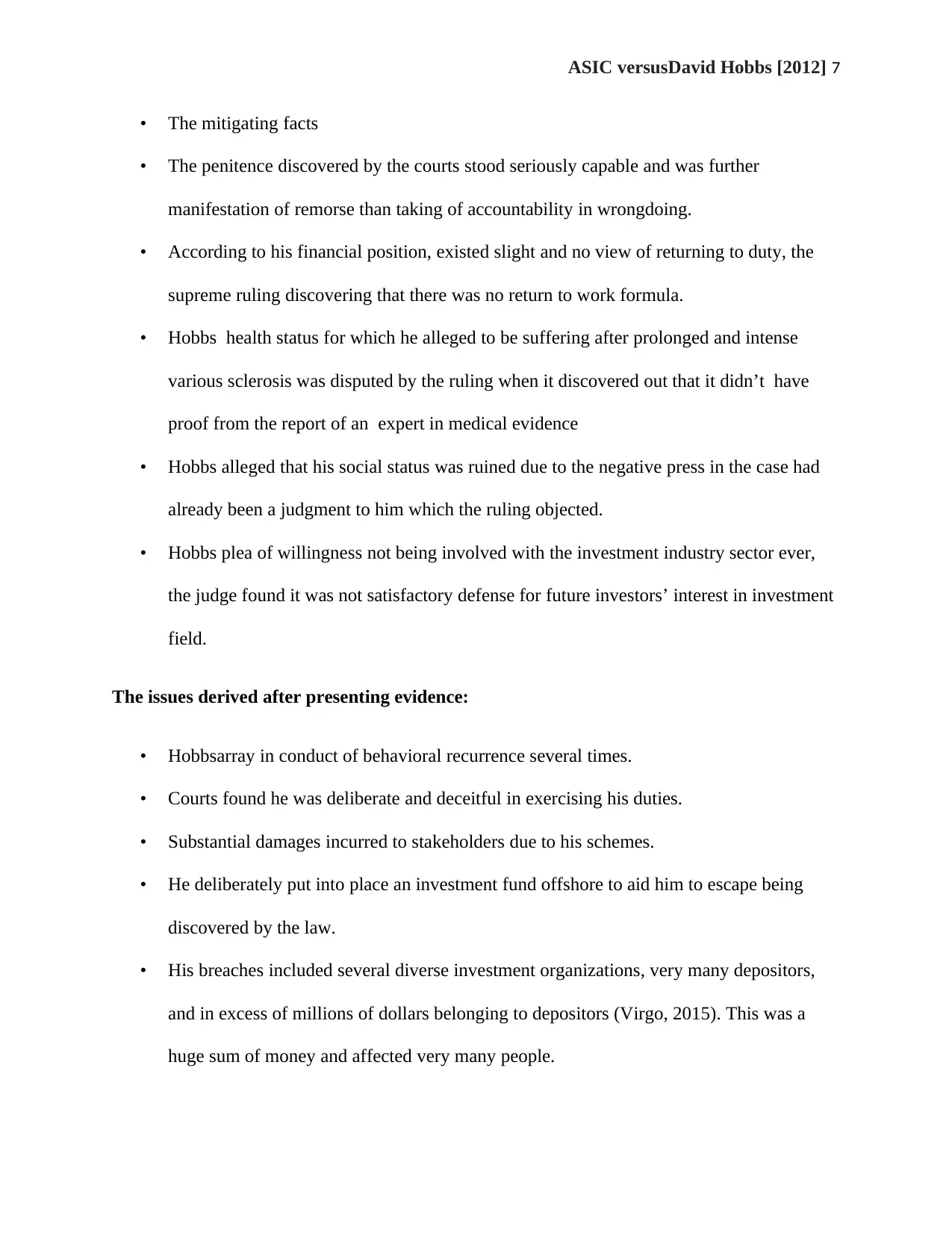
ASIC versusDavid Hobbs [2012] 7
• The mitigating facts
• The penitence discovered by the courts stood seriously capable and was further
manifestation of remorse than taking of accountability in wrongdoing.
• According to his financial position, existed slight and no view of returning to duty, the
supreme ruling discovering that there was no return to work formula.
• Hobbs health status for which he alleged to be suffering after prolonged and intense
various sclerosis was disputed by the ruling when it discovered out that it didn’t have
proof from the report of an expert in medical evidence
• Hobbs alleged that his social status was ruined due to the negative press in the case had
already been a judgment to him which the ruling objected.
• Hobbs plea of willingness not being involved with the investment industry sector ever,
the judge found it was not satisfactory defense for future investors’ interest in investment
field.
The issues derived after presenting evidence:
• Hobbsarray in conduct of behavioral recurrence several times.
• Courts found he was deliberate and deceitful in exercising his duties.
• Substantial damages incurred to stakeholders due to his schemes.
• He deliberately put into place an investment fund offshore to aid him to escape being
discovered by the law.
• His breaches included several diverse investment organizations, very many depositors,
and in excess of millions of dollars belonging to depositors (Virgo, 2015). This was a
huge sum of money and affected very many people.
• The mitigating facts
• The penitence discovered by the courts stood seriously capable and was further
manifestation of remorse than taking of accountability in wrongdoing.
• According to his financial position, existed slight and no view of returning to duty, the
supreme ruling discovering that there was no return to work formula.
• Hobbs health status for which he alleged to be suffering after prolonged and intense
various sclerosis was disputed by the ruling when it discovered out that it didn’t have
proof from the report of an expert in medical evidence
• Hobbs alleged that his social status was ruined due to the negative press in the case had
already been a judgment to him which the ruling objected.
• Hobbs plea of willingness not being involved with the investment industry sector ever,
the judge found it was not satisfactory defense for future investors’ interest in investment
field.
The issues derived after presenting evidence:
• Hobbsarray in conduct of behavioral recurrence several times.
• Courts found he was deliberate and deceitful in exercising his duties.
• Substantial damages incurred to stakeholders due to his schemes.
• He deliberately put into place an investment fund offshore to aid him to escape being
discovered by the law.
• His breaches included several diverse investment organizations, very many depositors,
and in excess of millions of dollars belonging to depositors (Virgo, 2015). This was a
huge sum of money and affected very many people.
Paraphrase This Document
Need a fresh take? Get an instant paraphrase of this document with our AI Paraphraser
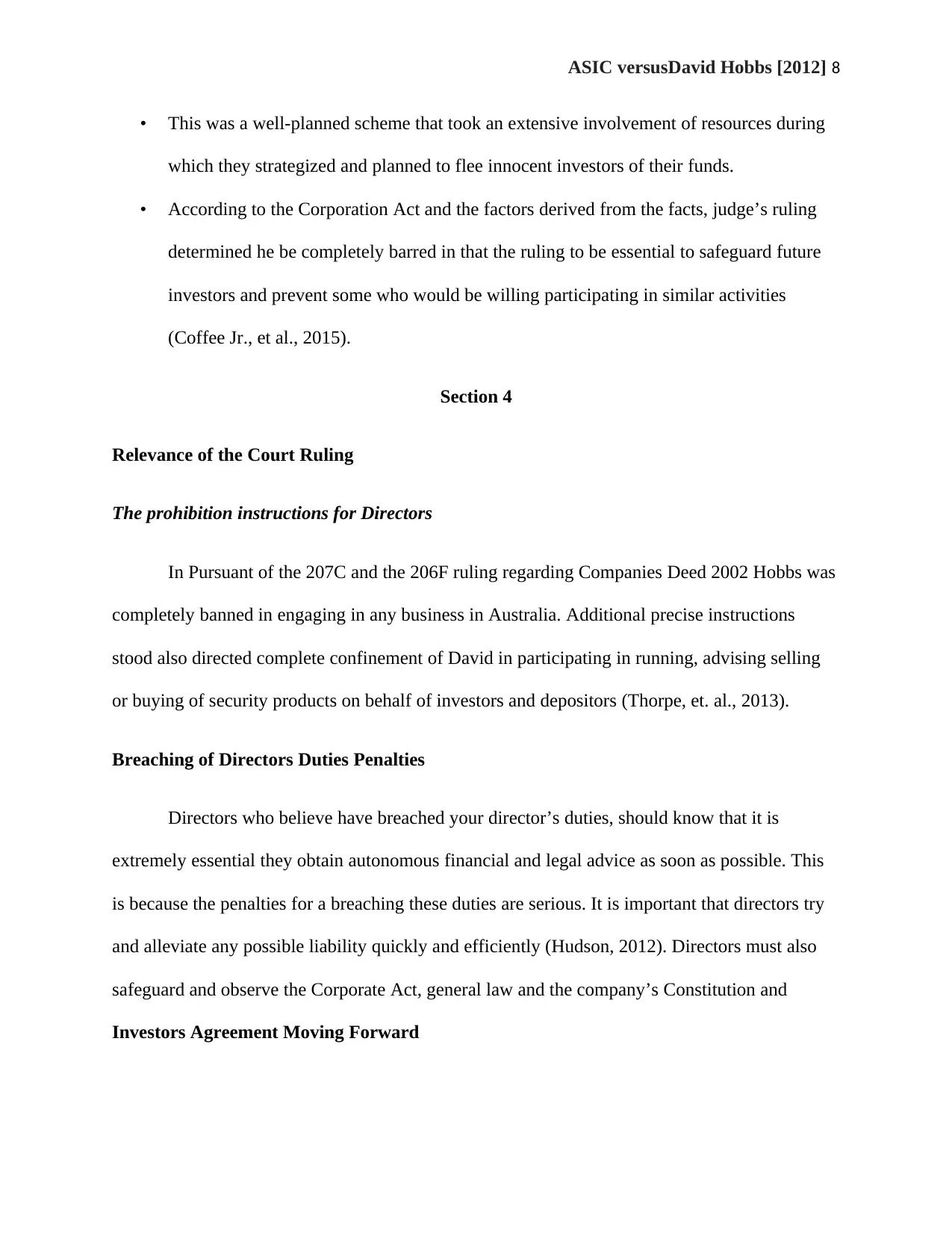
ASIC versusDavid Hobbs [2012] 8
• This was a well-planned scheme that took an extensive involvement of resources during
which they strategized and planned to flee innocent investors of their funds.
• According to the Corporation Act and the factors derived from the facts, judge’s ruling
determined he be completely barred in that the ruling to be essential to safeguard future
investors and prevent some who would be willing participating in similar activities
(Coffee Jr., et al., 2015).
Section 4
Relevance of the Court Ruling
The prohibition instructions for Directors
In Pursuant of the 207C and the 206F ruling regarding Companies Deed 2002 Hobbs was
completely banned in engaging in any business in Australia. Additional precise instructions
stood also directed complete confinement of David in participating in running, advising selling
or buying of security products on behalf of investors and depositors (Thorpe, et. al., 2013).
Breaching of Directors Duties Penalties
Directors who believe have breached your director’s duties, should know that it is
extremely essential they obtain autonomous financial and legal advice as soon as possible. This
is because the penalties for a breaching these duties are serious. It is important that directors try
and alleviate any possible liability quickly and efficiently (Hudson, 2012). Directors must also
safeguard and observe the Corporate Act, general law and the company’s Constitution and
Investors Agreement Moving Forward
• This was a well-planned scheme that took an extensive involvement of resources during
which they strategized and planned to flee innocent investors of their funds.
• According to the Corporation Act and the factors derived from the facts, judge’s ruling
determined he be completely barred in that the ruling to be essential to safeguard future
investors and prevent some who would be willing participating in similar activities
(Coffee Jr., et al., 2015).
Section 4
Relevance of the Court Ruling
The prohibition instructions for Directors
In Pursuant of the 207C and the 206F ruling regarding Companies Deed 2002 Hobbs was
completely banned in engaging in any business in Australia. Additional precise instructions
stood also directed complete confinement of David in participating in running, advising selling
or buying of security products on behalf of investors and depositors (Thorpe, et. al., 2013).
Breaching of Directors Duties Penalties
Directors who believe have breached your director’s duties, should know that it is
extremely essential they obtain autonomous financial and legal advice as soon as possible. This
is because the penalties for a breaching these duties are serious. It is important that directors try
and alleviate any possible liability quickly and efficiently (Hudson, 2012). Directors must also
safeguard and observe the Corporate Act, general law and the company’s Constitution and
Investors Agreement Moving Forward
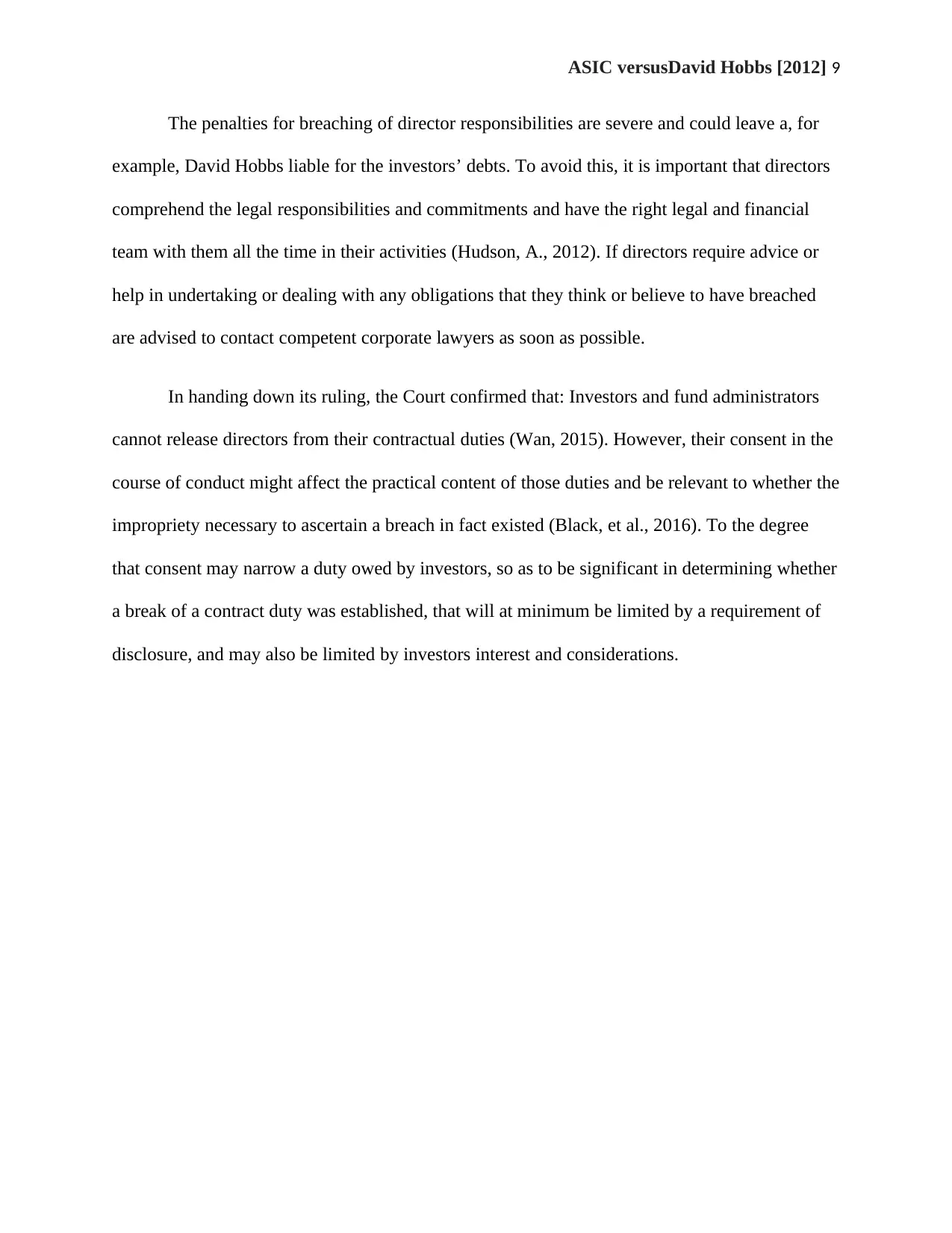
ASIC versusDavid Hobbs [2012] 9
The penalties for breaching of director responsibilities are severe and could leave a, for
example, David Hobbs liable for the investors’ debts. To avoid this, it is important that directors
comprehend the legal responsibilities and commitments and have the right legal and financial
team with them all the time in their activities (Hudson, A., 2012). If directors require advice or
help in undertaking or dealing with any obligations that they think or believe to have breached
are advised to contact competent corporate lawyers as soon as possible.
In handing down its ruling, the Court confirmed that: Investors and fund administrators
cannot release directors from their contractual duties (Wan, 2015). However, their consent in the
course of conduct might affect the practical content of those duties and be relevant to whether the
impropriety necessary to ascertain a breach in fact existed (Black, et al., 2016). To the degree
that consent may narrow a duty owed by investors, so as to be significant in determining whether
a break of a contract duty was established, that will at minimum be limited by a requirement of
disclosure, and may also be limited by investors interest and considerations.
The penalties for breaching of director responsibilities are severe and could leave a, for
example, David Hobbs liable for the investors’ debts. To avoid this, it is important that directors
comprehend the legal responsibilities and commitments and have the right legal and financial
team with them all the time in their activities (Hudson, A., 2012). If directors require advice or
help in undertaking or dealing with any obligations that they think or believe to have breached
are advised to contact competent corporate lawyers as soon as possible.
In handing down its ruling, the Court confirmed that: Investors and fund administrators
cannot release directors from their contractual duties (Wan, 2015). However, their consent in the
course of conduct might affect the practical content of those duties and be relevant to whether the
impropriety necessary to ascertain a breach in fact existed (Black, et al., 2016). To the degree
that consent may narrow a duty owed by investors, so as to be significant in determining whether
a break of a contract duty was established, that will at minimum be limited by a requirement of
disclosure, and may also be limited by investors interest and considerations.
⊘ This is a preview!⊘
Do you want full access?
Subscribe today to unlock all pages.

Trusted by 1+ million students worldwide

ASIC versusDavid Hobbs [2012] 10
References list
Burrows, A. ed., 2015. Principles of the English Law of Obligations. Oxford University Press,
USA.
Black, et al., 2016. Outside director liability: A policy analysis. Journal of Institutional and
Theoretical Economics JITE, 162(1), pp.5-20.
Coffee Jr, et al., 2015. Securities regulation: Cases and materials.
Gibelman, M. and Gelman, S.R., 2001. Very public scandals: Nongovernmental organizations in
trouble. Voluntas: International Journal of Voluntary and Nonprofit Organizations, 12(1),
pp.49-66.
Haigh, Matthew, and Marc T. Jones. "The drivers of corporate social responsibility: A critical
review." (2006).
Hudson, A., 2012. Equity and trusts.Routledge
Hanrahan, P.F., 2014. Should the FSI revisit the philosophy of financial services regulation?.Law
and Financial Markets Review, 8(3), pp.199-203.
Hjalmarsson, J. and Merkin, R., 2016. Singapore Arbitration Legislation: Annotated. Informa
Law from Routledge.
Langford, R. and Ramsay, I., 2014. Conflicted directors: What is required to avoid a breach of
duty?
McDermott, P.A., 2017. Contract law.Bloomsbury Publishing.
References list
Burrows, A. ed., 2015. Principles of the English Law of Obligations. Oxford University Press,
USA.
Black, et al., 2016. Outside director liability: A policy analysis. Journal of Institutional and
Theoretical Economics JITE, 162(1), pp.5-20.
Coffee Jr, et al., 2015. Securities regulation: Cases and materials.
Gibelman, M. and Gelman, S.R., 2001. Very public scandals: Nongovernmental organizations in
trouble. Voluntas: International Journal of Voluntary and Nonprofit Organizations, 12(1),
pp.49-66.
Haigh, Matthew, and Marc T. Jones. "The drivers of corporate social responsibility: A critical
review." (2006).
Hudson, A., 2012. Equity and trusts.Routledge
Hanrahan, P.F., 2014. Should the FSI revisit the philosophy of financial services regulation?.Law
and Financial Markets Review, 8(3), pp.199-203.
Hjalmarsson, J. and Merkin, R., 2016. Singapore Arbitration Legislation: Annotated. Informa
Law from Routledge.
Langford, R. and Ramsay, I., 2014. Conflicted directors: What is required to avoid a breach of
duty?
McDermott, P.A., 2017. Contract law.Bloomsbury Publishing.
Paraphrase This Document
Need a fresh take? Get an instant paraphrase of this document with our AI Paraphraser

ASIC versusDavid Hobbs [2012] 11
Sparkes, R. and Cowton, C.J., 2004. The maturing of socially responsible investment: A review
of the developing link with corporate social responsibility. Journal of Business
Ethics, 52(1), pp.45-57.
Stapledon, G.P., 2011. Institutional shareholders and corporate governance.Oxford University
Press.
Thorpe, D., Buti, A., Davies, C., Fridman, S. and Jonson, P., 2013.Sports law.Oxford University
Press
Virgo, G., 2015. Principles of the Law of Restitution. Oxford University Press, USA.
Wan, W.Y., 2015. Directors’ defence of reliance on professional advisers under Anglo-
Australian law.Common Law World Review, 44(1), pp.71-93.
Witting, C., 2015. Street on Torts. Oxford University Press, USA.
Sparkes, R. and Cowton, C.J., 2004. The maturing of socially responsible investment: A review
of the developing link with corporate social responsibility. Journal of Business
Ethics, 52(1), pp.45-57.
Stapledon, G.P., 2011. Institutional shareholders and corporate governance.Oxford University
Press.
Thorpe, D., Buti, A., Davies, C., Fridman, S. and Jonson, P., 2013.Sports law.Oxford University
Press
Virgo, G., 2015. Principles of the Law of Restitution. Oxford University Press, USA.
Wan, W.Y., 2015. Directors’ defence of reliance on professional advisers under Anglo-
Australian law.Common Law World Review, 44(1), pp.71-93.
Witting, C., 2015. Street on Torts. Oxford University Press, USA.
1 out of 11
Your All-in-One AI-Powered Toolkit for Academic Success.
+13062052269
info@desklib.com
Available 24*7 on WhatsApp / Email
![[object Object]](/_next/static/media/star-bottom.7253800d.svg)
Unlock your academic potential
Copyright © 2020–2025 A2Z Services. All Rights Reserved. Developed and managed by ZUCOL.